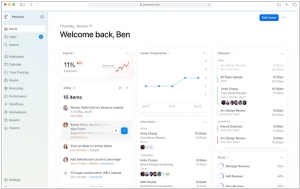LibreOffice vs iWork
October 13, 2024 | Author: Adam Levine
14★
LibreOffice is the power-packed free, libre and open source personal productivity suite for Windows, Macintosh and GNU/Linux, that gives you six feature-rich applications for all your document production and data processing needs: Writer, Calc, Impress, Draw, Math and Base. Support and documentation is free from our large, dedicated community of users, contributors and developers. The online and mobile version (for Android and iPad) are coming soon
5★
iWork has always been the best way to be productive on the Mac. And iWork for iOS made it easy to create beautiful documents on iPad and iPhone. With iWork for iCloud we’re bringing Pages, Numbers, and Keynote to the web — on Mac and PC. And thanks to iCloud, your work is always up to date on all your devices. It’s easy to work with Microsoft Word, Excel, and PowerPoint files. iWork alternative for PC is Office 365.
See also:
Top 10 Office suites
Top 10 Office suites
LibreOffice and iWork are, in essence, two very different ways to avoid paying for Microsoft Office while pretending not to notice you're doing exactly that. LibreOffice, for instance, is what happens when a group of well-meaning software enthusiasts get together and decide that what the world really needs is yet another office suite, only this one is open-source, which means it’s free and not in the “someone’s watching your every move” way, but the “community-built and sometimes confusingly updated” kind of free. With Writer, Calc and Impress in its toolbox, LibreOffice lets you write documents, crunch numbers and make presentations that sometimes resemble what you actually intended, while quietly attempting to interpret whatever file format you’ve thrown at it with a hopeful whirr.
iWork, on the other hand, is Apple's idea of what an office suite should look like if you had no intention of ever sharing anything with people who use Windows. Pages, Numbers and Keynote are not so much applications as they are design statements—crafted for the smooth, minimalist world where the user interface is so sleek you almost forget you’re supposed to be working. iWork's integration with all things Apple is so seamless it feels as if your MacBook is smugly watching from the corner, knowing you’d never dare use anything else.
In the grand cosmic battle of office suites, LibreOffice is the slightly eccentric, occasionally confusing cousin who insists on doing things their own way, while iWork is the cool, design-conscious sibling who looks great but only plays nicely with their own friends. Both are excellent alternatives—assuming, of course, you don’t accidentally send your iWork document to a LibreOffice user and then spend an hour wondering why it looks like it was formatted by a particularly malicious alien intelligence.
See also: Top 10 Office suites
iWork, on the other hand, is Apple's idea of what an office suite should look like if you had no intention of ever sharing anything with people who use Windows. Pages, Numbers and Keynote are not so much applications as they are design statements—crafted for the smooth, minimalist world where the user interface is so sleek you almost forget you’re supposed to be working. iWork's integration with all things Apple is so seamless it feels as if your MacBook is smugly watching from the corner, knowing you’d never dare use anything else.
In the grand cosmic battle of office suites, LibreOffice is the slightly eccentric, occasionally confusing cousin who insists on doing things their own way, while iWork is the cool, design-conscious sibling who looks great but only plays nicely with their own friends. Both are excellent alternatives—assuming, of course, you don’t accidentally send your iWork document to a LibreOffice user and then spend an hour wondering why it looks like it was formatted by a particularly malicious alien intelligence.
See also: Top 10 Office suites





